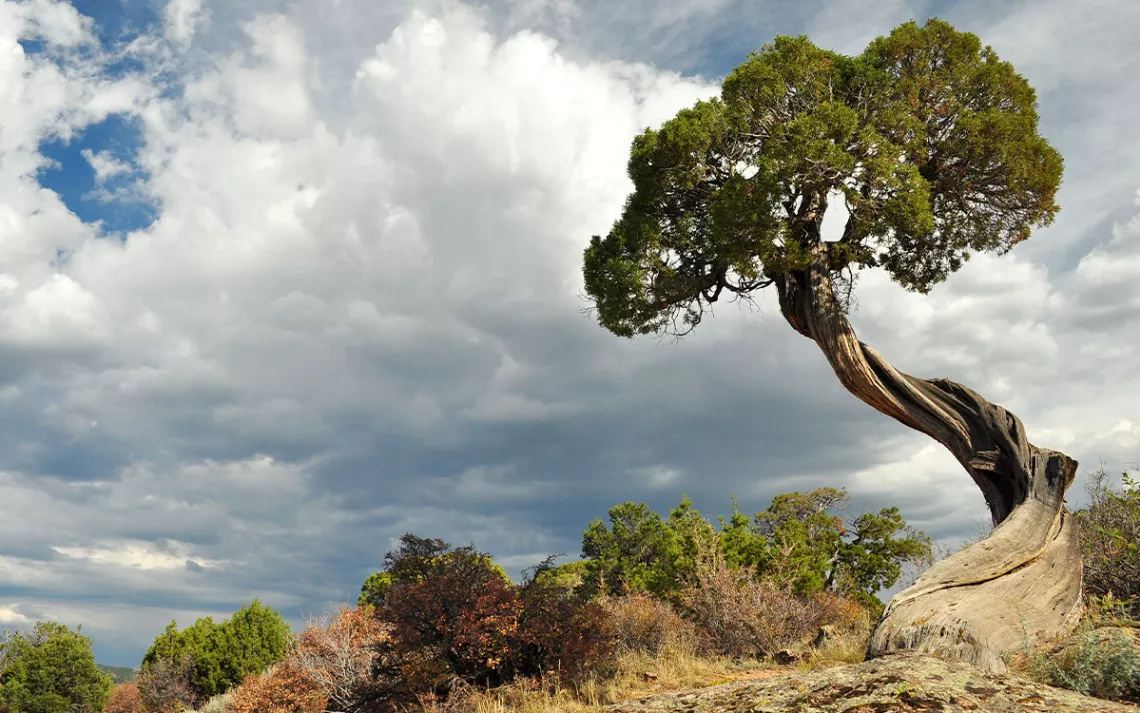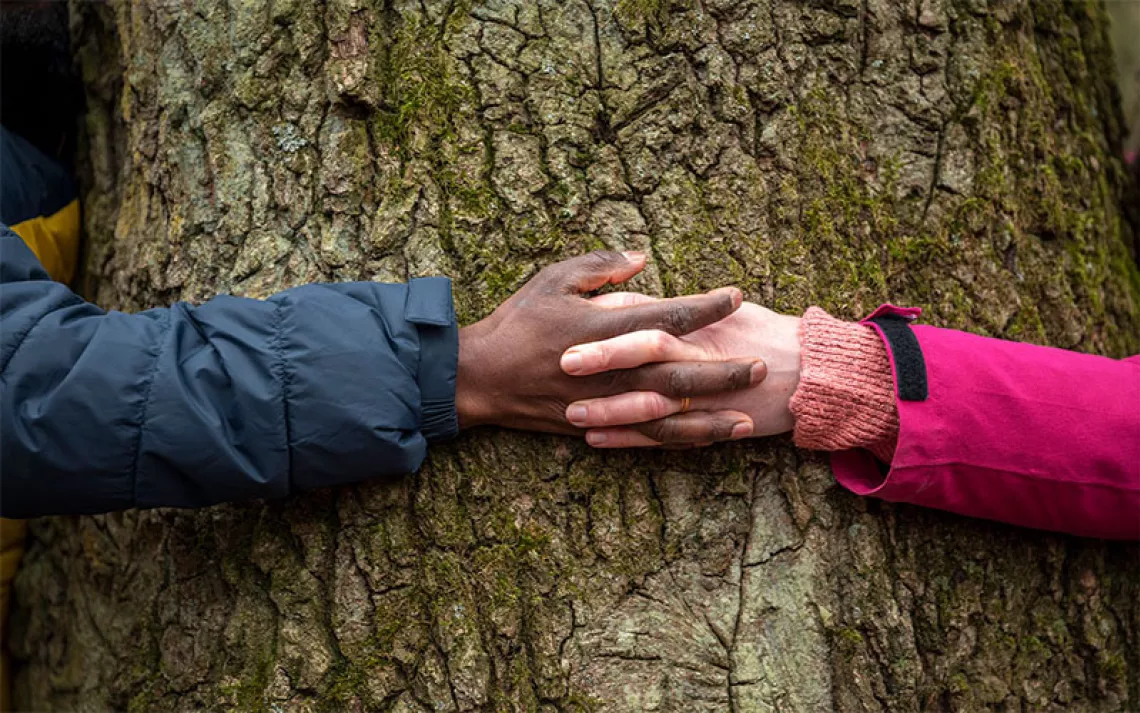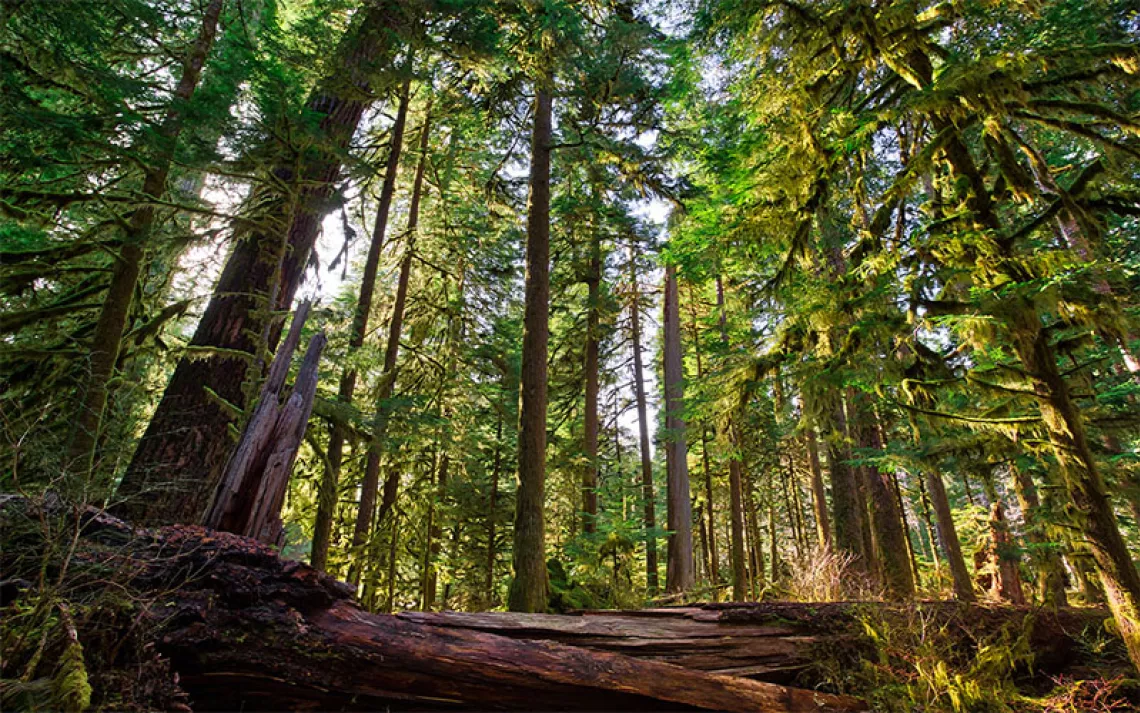Why Is the Bureau of Land Management Still Clearcutting Piñon-Juniper Landscapes?
Conservationists had hoped the practice would pause with the end of the Trump administration, but the war on native trees continues

During the last century, federal agencies have undertaken a campaign to destroy huge tracts of piñon pines and juniper trees in the arid reaches of the American West. These hardy native trees collectively cover 100 million acres across the Great Basin and Colorado Plateau. In the middle of the 20th century, this deforestation campaign was undertaken overtly in the name of increasing pasturage for cattle. These days, the cutting, chaining, and burning has taken on a different cast, presented as a way to protect threatened species or to reduce fire risk.
Four years ago, I wrote a story for this magazine about this pattern of ecological destruction. It was the third year of the Trump administration’s open assault on the West’s public lands, and dozens of so-called treatment projects were underway across the West. In northeastern Nevada, near Ely, a massive tract of piñon-juniper forest on land managed by the Bureau of Land Management had been pulverized by a massive chain dragged between two bulldozers. The woody debris that remained was chewed to bits by hulking, noisy machines called bullhogs and giant masticators.
Another project, in the Owyhee Mountains in southwestern Idaho, had reduced a massive parcel of old-growth western juniper trees to charred husks. This was no small-scale, low-intensity strategic fire but a conflagration that incinerated 13,000 acres of forest. Many of the trees on the aptly named Juniper Mountain were tall and gnarled, easily hundreds of years old. In places, the fire had raged so intensely that the soil was transformed to a lifeless, blackened hardpan.
Conservationists were cautiously optimistic that the widescale razing of piñon and juniper forests would abate under the leadership of Joe Biden, who vowed in his 2020 campaign to pursue aggressive climate and environmental protection initiatives.
But four years into Biden’s first term, little has changed, according to several ecologists and activists I spoke with. In fact, the government logging seems to be getting worse. “I see the same policies and management under the Democrats as under the Republicans,” said Laura Cunningham, an ecologist with Basin and Range Watch. “For some reason, this war on native trees never ends.”
Cunningham said there are currently dozens of projects underway in the western reaches of the Great Basin. “Almost too many to keep track of,” she said. One of the most concerning projects unfolding is in Lincoln County, in southeastern Nevada. Earlier this year, Nevada governor Joe Lombardo signed a declaration of understanding with Denmark to build an industrial park and plant that would transform wood harvested from 1.6 million acres of piñon and juniper into so-called green methanol. According to the Los Angeles Times, the project could create 150 jobs in the region. “The trees have no commercial lumber value,” a press release from Governor Lombardo’s office said, “yet they have a high fuel content and are ideal as a lucrative feedstock for thermochemical processing into biofuels.”
The Danish government, for its part, sees the Lincoln County project as a move toward its national climate goals of generating 100 percent of its power with renewable energy by 2050. “Denmark is at the forefront of renewable energy developments, and closer collaboration between Nevada and Denmark can only strengthen our joint quests to create economic growth and well-paid jobs—while also doing good for the environment and our planet,” said Danish ambassador to the US Jesper Møller Sørensen in a prepared statement from the Nevada Governor’s Office of Economic Development. It’s not clear, however, how the proposed logging of thousands of acres of arid land forests, which collectively sequester metric tons of carbon, is in line with those goals. Environmental organizations and academics in the US and the EU have long complained that logging forests in North America to provide fuel to Europe is a climate boondoggle.
Patrick Donnelly, Great Basin director of the Center for Biological Diversity, called the project a “frightening escalation in the piñon-juniper wars” because it could make destroying remote and rugged swaths of drylands forests profitable. “The main limiting factor on piñon and juniper deforestation has been that it costs a lot of money,” Donnelly said. “There’s never been a way to make money on it. But now there’s going to be an economic motive to cut down more and more. If it works, you could see copycats throughout the Great Basin.”
Another major piñon-juniper clearance project that has environmentalists concerned is unfolding in the South Spring Valley, along the southwestern boundary of Great Basin National Park. Last November, a federal judge allowed a 380,000 clearance on BLM land to move forward.
Donnelly said that it is not only one of the biggest piñon-juniper deforestation projects he’s ever seen, but it is unfolding in vital habitat for hundreds of species including the pinyon jay, whose numbers have plummeted by an estimated 80 percent over the last 50 years. It’s not just deforestation that threatens the pinyon jay, but a mass die-off of piñon pines following a megadrought that racked the Southwest between 2000 and 2022.
Pine nuts remain an important food source for tribes throughout the West, including the Western Shoshone, whose homelands encompass the Spring Valley. In years when game was scarce, survival could depend solely on the high protein bounty of the piñon tree. But the trees are notoriously fickle, in some cases producing nuts only once every three to four years. And if a crop failed, which happened often, starvation soon followed.
“My people have lived here sustainably for over 10,000 years,” said Western Shoshone elder and activist Rick Spilsbury in an interview with the environmental group Deep Green Resistance about the Spring Valley project. “We want that for all of the Earth for another 10,000 years.”
“This isn’t just another project,” Donnelly told Sierra. “This is one of the best, last great places. The [BLM] happened to choose one of the most important regions to the ecology and Indigenous people of the Great Basin.”
Smaller piñon and juniper removal projects also pose a threat, Cunningham said. That is because many of them proceed without environmental review or public input. “On federal lands, they can just do a cut and you don’t even know about it,” Cunningham said. (This is all happening, she said, despite the fact that the BLM issued a memorandum last year eliminating the use of categorical exclusions for piñon-juniper logging projects.) “It’s all very untransparent verging on illegal. But it’s also very hard to win these cases because the judges tend to defer to the federal agencies.”
These days, the BLM and US Forest Service tend to speak about the trees in abstract terms—as an “encroaching” threat to wildlife habitat for the sage grouse, or a growing fire risk—to justify deforestation projects. But still the old myths persist, says Adam Bornstein, Oregon director of the Western Watersheds Project. Among some land managers, the trees are still derided as a nuisance, a water-hogging blight, a noxious weed, even a toxic threat to cattle herds. All of it amounts to a disinformation campaign, Bornstein said. “There's a lot of very disrespectful language towards these native ecosystems that are just responding to human impacts and stressors,” Bornstein told me. “Most of it is ecological hate speech.”
Bornstein noted that many of the large fire “treatment” projects in the Great Basin have contributed to the spread of highly flammable cheatgrass, which in turn has increased fire risk. “The whole wildfire crisis strategy is just ramping up,” he said. “Hundreds of millions of dollars are going into fuels and vegetation treatments around communities. There is increased spending everywhere, which is just making us less safe.”
Patrick Donnelly of the Center for Biological Diversity said he fears the 2024 presidential election holds little hope for a change in direction on the management of the West’s arid land forests. “The assault on piñon-juniper forests is a purely bipartisan affair,” he said. “The Trump administration certainly didn’t back off one inch on P-J deforestation, and indeed they put forward these broad programmatic environmental impact statements to try to streamline permitting for piñon and juniper removal even more.”
“We’ve seen a continuation of those policies under President Biden,” he added. “So, in short, I don’t think electoral politics plays a big role in this issue because both Democrats and Republicans seem equally willing to clearcut piñon and juniper forests.”
Donnelly said the only way to curb this destruction that has become enshrined across the Great Basin and Colorado Plateau is to reform the land management agencies—particularly the BLM—carrying out the deforestation. “They don’t call them the Bureau of Livestock and Mining for nothing,” said Donnelly.
He continued: “There needs to be a re-evaluation of our relationship to these ecosystems.… And there needs to be a wholesale reorientation of land management agencies and goals. Until then, BLM has really stacked the deck against us.”
 The Magazine of The Sierra Club
The Magazine of The Sierra Club



